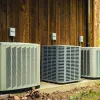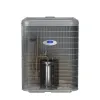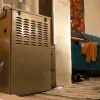This article is Part 4 of our series on Manual J load calculations for new HVAC installations.
So, a contractor just completed a Manual J load calculation for your home. You’ve got the results, and the ball is very much in your court. What should your next move be?
For one thing, you should do whatever you can to get a properly sized HVAC system for your home. What’s your top priority? It’s also why you had the load calculation done in the first place. But depending on your situation, there could be more involved than just saying “yes, please!” to a new, right-sized HVAC system.
Let’s have a look at some decisions you might have to make before installing the system indicated by your load calculation. In many cases, the right move is very straightforward… but not always.
The first step: Manual S helps you choose the right AC and furnace.
We often talk about Manual J as the key to choosing the right HVAC system. That’s true, but Manual J just tells us the heating and cooling loads your HVAC system will need to accommodate. The ACCA’s Manual S (Residential Equipment Selection) keeps the ball rolling, so to speak, by showing which furnace and AC will properly handle those loads.
If Manual J is like a mechanic’s assessment of a misbehaving car, Manual S is the mechanic’s recommendation for replacing the faulty parts. You can’t have one without the other, and both are important.
So before you make any big decisions following a Manual J load calculation, your contractor should also run through the Manual S protocol. That way, you’ll know which HVAC components you’ll need to handle the loads.
Good news: You might not have to do anything “extra.”
So, you’ve got your Manual J results. Will you have to make changes to prepare your home for a properly sized HVAC system? In many cases, you won’t have to do anything. This is the best-case scenario, and it’s pretty common!
When your home’s existing HVAC infrastructure (ductwork, plenums, grilles, registers, and so forth) will accommodate a larger or smaller system, you won’t need to make changes in addition to installing a new AC and furnace. This happens more often than you might think because:
- Many homes already have ducts that are too small for the existing HVAC system. When your load calculation indicates a need for smaller HVAC equipment, your existing ductwork might be a-ok, even if it wasn’t ok previously.
- You may have the right size system and the right size ductwork already, so you won’t need to change anything.
There’s no reason to think you’ll have to make ductwork modifications or change anything about your home just so you can get the right HVAC system. Some people will, but not everyone.
A new system could require new or extra ductwork.
If you do have to make changes, they will probably involve your ductwork. To work properly, your new, right-sized system could require larger or smaller ducts – and they might need to be rerouted.
For example, when ducts are too small, it can be hard for the system to move air through them effectively. You might not get the airflow you need to make a particular room feel comfortable, or you might get too much airflow in certain areas and too little in others. This situation can also overwork the blower fan, causing it to fail prematurely.
If you’ve ever heard of static pressure – and, in particular, high static pressure – these are some of the potential consequences.
Imagine you’re building addition and you want to use your existing HVAC infrastructure to heat and cool it. Following the Manual J load calculation, you learn that your 3-ton AC will no longer be able to cool the addition and the rest of your home. To stay comfortable, you’ll need a 4-ton AC.
The problem? Your ducts are too small to accommodate the airflow produced by the more powerful system. You’ll have to replace and balance the ducts so that the new system works properly. You could also find that…
New ductwork = new air return grilles and supply registers.
These are the vents where the air gets pulled into the system (return) and blown out (supply) after being heated or cooled. When you change something about your ducts, you might need a larger or smaller return and supply vents. Here’s why:
- A bigger duct might need a bigger “boot” to fit on the end of it. When this is the case, your vents might increase in size, but only slightly.
- Your grilles and registers might have been the wrong size, to begin with (it’s common!). Ductwork modifications present a good opportunity for fixing the problem.
- If you need to re-route some of the ductwork, you might need new grilles or registers in different parts of your home.
These changes are pretty simple and often go along with ductwork modifications. They’re not a big deal, construction-wise, but just know they might be necessary.
What about other factors that impact heat transfer… like insulation?
Some homeowners know they want to replace their windows or bulk up their insulation before purchasing new HVAC equipment. That’s a great idea, but keep in mind that all of these changes impact the load. If you’re planning major energy efficiency upgrades, the contractor performing your load calculation needs to know about them.
For example, a poorly insulated home with lots of air leaks between the living space and the ceiling might need a 3-ton AC under current conditions. But if you’re already planning to air-seal the attic and beef up the insulation to R-38, those changes could change your load calculation results.
You’ll have to let your contractor know you’re planning these upgrades so they can address the changes in the load calculation. To ensure quality performance, you should also have the work done before installing a new HVAC system.
What if it’s not in the budget?
Say you need to modify your ductwork to achieve proper airflow and comfort with a different-sized HVAC system, but your budget only allows for HVAC system replacement. What can you do?
In this situation, you simply have to weigh your options. You could:
- Get a new system anyway. Your ductwork might not allow for proper airflow, even with a system that’s the “right” size. However, you could upgrade the system this year and fix your ductwork the following year to optimize your budget. A lot of people go this route.
- Keep your existing system and wait. If your current system still works and you just need to wait until you can afford the upgrades, you can always just hold tight.
- Get a new system that’s the same size as your old one. It might not provide adequate comfort, but at least you know what you’re in for. The system will probably perform similarly to whatever you’re replacing.
We always recommend the best possible solution, but we also understand that budgets are, well… budgets. You’ve got to do what makes the most sense for you.
Who should make the changes and perform the installation?
Ideally, the company who performed the Manual J load calculation will also be able to install new HVAC equipment. If you have to choose another contractor to install the HVAC equipment, make sure they:
- Can competently perform any necessary changes to ductwork or other HVAC infrastructure
- Audit and test their work; a supervisor should review the installation after completion to ensure it meets the highest standard. Testing ensures that the system performs properly.
- Offer a quality labor warranty; as an example, we warranty our labor for 10 years when you sign up for a service agreement following an installation.
The bottom line? A load calculation is incredibly helpful, but it’s far less helpful when you follow it up with a sub-par HVAC installation. Working with a reputable contractor can help you avoid that problem and stay comfortable for years to come.






